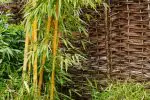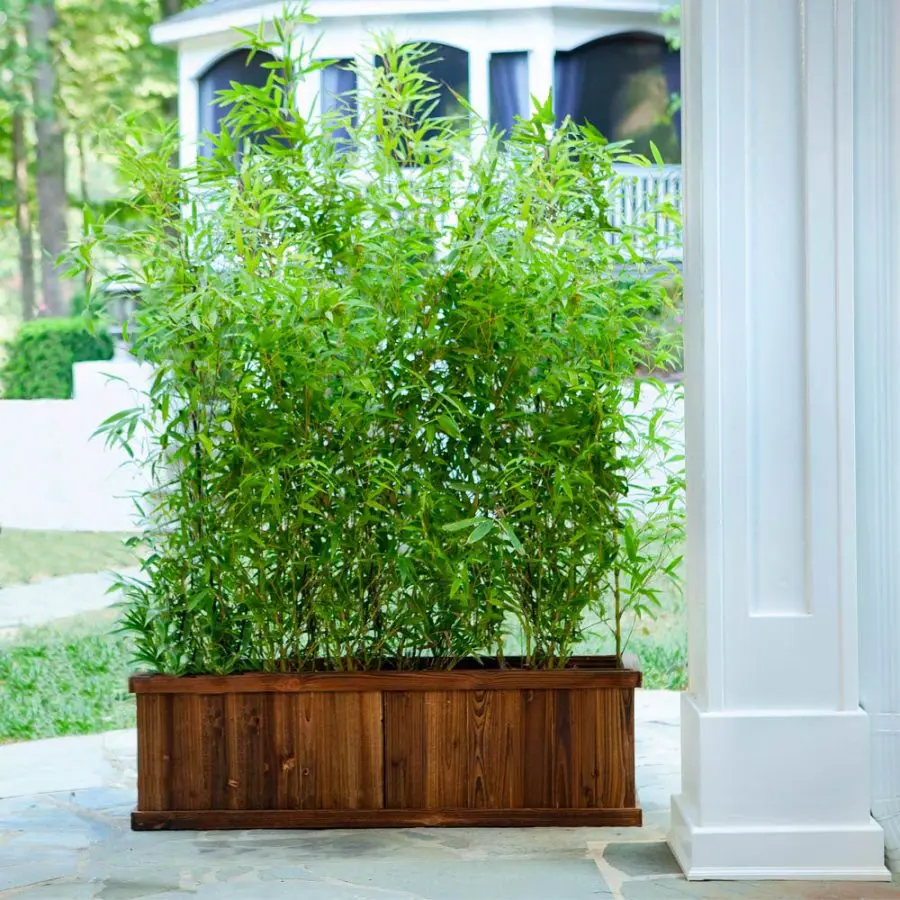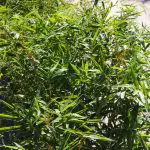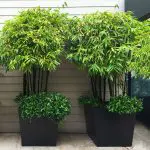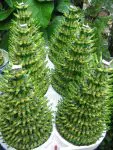This post contains affiliate links. If you buy something from one of our links we may earn a commission. Thanks
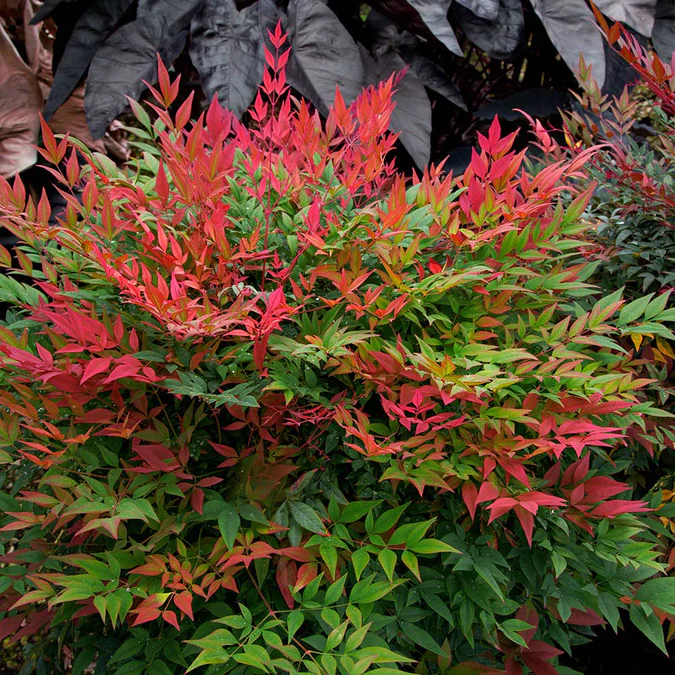
Buy Your Obsession Nandina Shrub Here
Transform your space with a touch of greenery! Discover the secret to growing Heavenly Bamboo in pots – the perfect indoor and outdoor companion.
Growing Nandina domestica or Heavenly Bamboo in pots is simple. Use well-draining soil and a pot with drainage holes. Place the pot in partial shade to full sun. Water regularly but let the soil dry out between waterings. Fertilize every 4-6 weeks during the growing season for best results.
Welcome, plant lovers! If you’re on the hunt for a low-maintenance, versatile green friend, look no further than Heavenly Bamboo in pots!
Whether you have an outdoor oasis or a cozy indoor nook, this hardy plant is sure to add a touch of zen and beauty to any space.
So, let’s get our hands dirty and discover how to cultivate this plant in pots, together!
Introduction To Heavenly Bamboo in pots
Hey there! Today, we’re going to dive into the wonderful world of growing plants in pots – specifically, Heavenly Bamboo in pots!
You may know it as Nandina domestica though I think Heavenly Bamboo is used more commonly.
Whether you’re an experienced green thumb or just starting out, growing plants in pots is a fantastic way to add a touch of nature to your space.
In this post, we’ll explore the ins and outs of growing Heavenly Bamboo in pots both indoors and outdoors, so you can enjoy its beauty and benefits wherever you are.
We will also preview 3 of the most colorful Heavenly Bambo strains that you can grow at home. Most are hardy down to 0° but they are excellent houseplants too.
So, let’s get started!
Welcome to our guide to growing Heavenly Bamboo in pots! Heavenly Bamboo, also known as Nandina domestica, is a beautiful evergreen shrub that’s often used for landscaping.
Another common name for this plant is Sacred Bamboo. It’s a hardy plant that’s easy to care for, making it a great choice for both experienced and novice gardeners.
In this post, we’ll explore why growing Heavenly Bamboo in pots may be a good option, and we’ll provide tips for growing it both indoors and outdoors.
Why Growing Heavenly Bamboo in Pots is a Good Option
Growing Heavenly Bamboo in pots offers several benefits.
First, it’s a great way to add a touch of greenery to your space, even if you don’t have a garden or outdoor space.
Second, it allows you to control the plant’s growth, which can be helpful if you have limited space or if you want to keep the plant at a certain size.
Finally, growing Heavenly Bamboo in pots makes it easier to move the plant around, which can be helpful if you want to change up your décor or if you need to protect the plant from harsh weather conditions.
Topics Covered in this Post
In this post, we’ll cover everything you need to know to grow Heavenly Bamboo in pots both indoors and outdoors. Specifically, we’ll cover:
• Variety selection
• Pot selection and placement considerations
• Soil and fertilizer requirements
• Tips for watering and drainage
• Pruning and maintenance needs
• Common pests and diseases to watch out for
By the end of this post, you’ll have all the information you need to successfully grow Heavenly Bamboo in pots and enjoy its beauty and benefits in your own space.
Heavenly Bamboo Isn’t bamboo at all
Despite its name, Heavenly Bamboo (Nandina domestica) isn’t actually bamboo at all.
It’s a member of the Berberidaceae family, which includes other ornamental plants like the Oregon grape and barberry.
Heavenly Bamboo gets its name from its bamboo-like appearance, with tall, slender stems and leaves that are arranged in a similar way to bamboo.
However, there are some key differences between Heavenly Bamboo and true bamboo plants.
For example, true bamboo plants are part of the grass family, while Heavenly Bamboo is a shrub.
Additionally, bamboo plants have hollow stems, while Heavenly Bamboo’s stems are solid.
So while Heavenly Bamboo may look like bamboo, it’s a distinct plant species with its own unique characteristics.
What Is Nandina domestica
Nandina domestica, commonly known as Heavenly Bamboo, is an evergreen plant native to Japan, China, and India.
Despite its common name, it is not related to bamboo but rather belongs to the family Berberidaceae.
Heavenly Bamboo has a distinctive appearance, featuring cane-like stems that are upright and arching, with new foliage starting as small green leaves that turn to pink and finally a deep red foliage color in the fall.
It also produces small white flowers in the spring, which are followed by bright red berries that persist into winter.
The mature height and spread of Nandina domestica can vary depending on the cultivar and growing conditions, but on average, it typically grows to a height of 2-3 feet and a spread of 2-3 feet.
Its compact size lends it well as a houseplant.
They can easily be pruned to maintain a desired height and they are relatively slow-growing plants.
Heavenly Bamboo is a popular ornamental plant in gardens and landscapes often used for foundation plantings, low hedges, or in mass plantings due to its attractive appearance and versatility in various growing conditions.
There are quite a few varieties of Heavenly Bamboo nandina and some with the most beautiful foliage that is popular are Blush Pink, Burgundy Wine, Domestica, Firepower, Flirt, Gulf Stream, Harbor Dwarf, and Obsession.
Top 3 Nandia Varieties To Try
Discover the Beauty of Fire Power Nandina
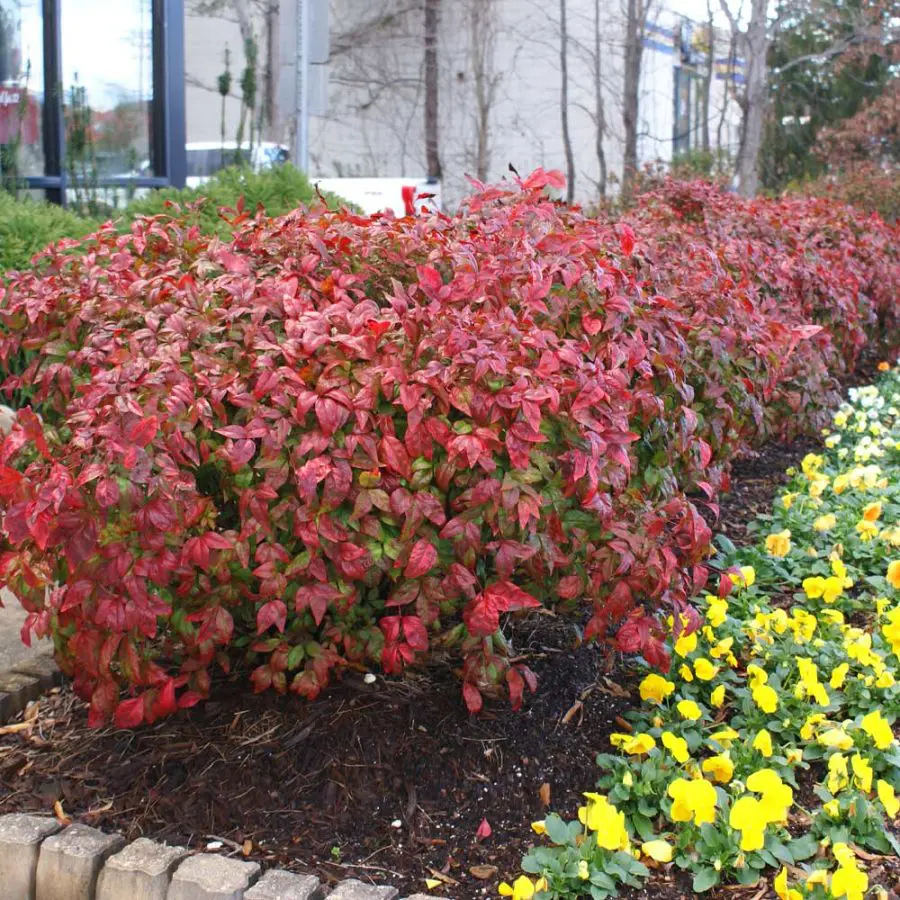
If you’re looking for a shrub that can add color, texture, and interest to your outdoor space, consider the Obsession Nandina.
This stunning plant is known for its bamboo-like stalks and delicate fern-like foliage, which combine to create a vibrant, eye-catching display.
One of the most impressive things about the Fire Power Nandina is its ability to maintain its beauty all year round.
In the spring, it produces bright white blooms and lush green foliage, which gradually turn a fiery red as the temperatures begin to drop in the fall.
And even in the depths of winter, when many other plants have withered away, the Fire Power Nandina continues to blaze with brilliant hues of red and orange.
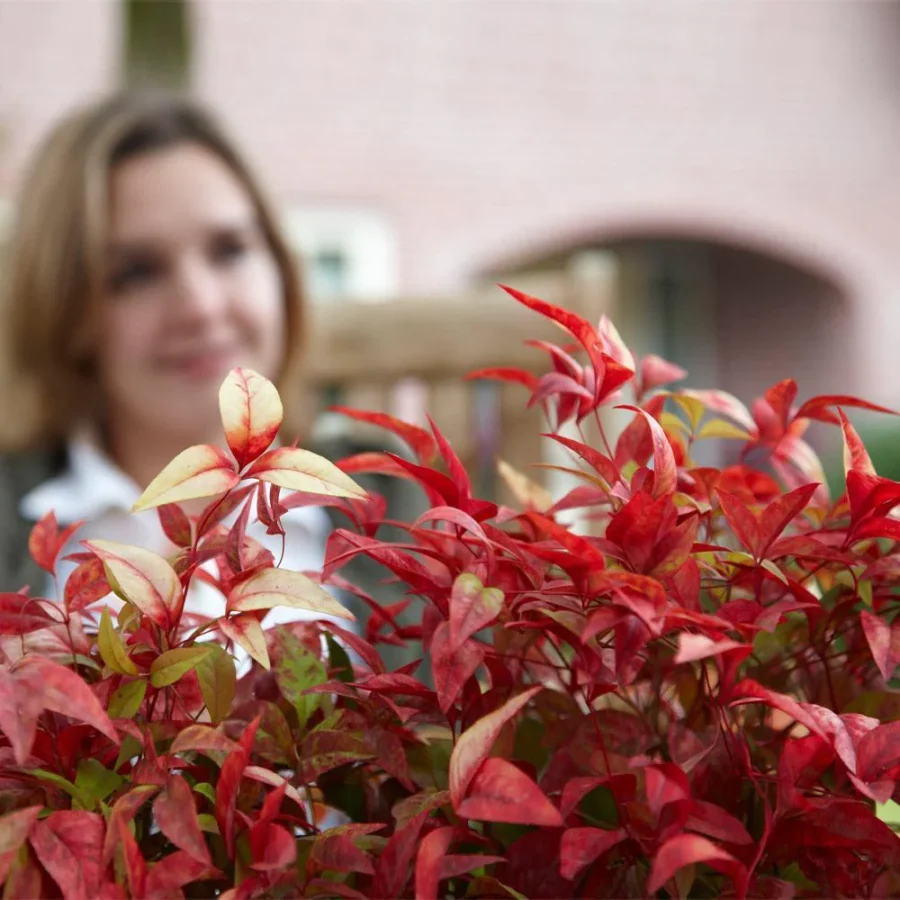
| Mature Height: | 2-3 ft. |
| Mature Width: | 2-3 ft. |
| Sunlight: | Full-Partial |
| Growth Rate: | Moderate |
| Botanical Name: | Nandina domestica ‘Fire Power’ |
| Grows Well In Zones: | 6-10 outdoors |
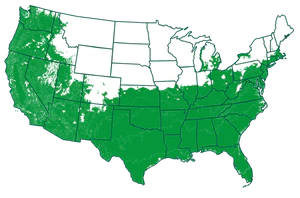
Growing Zones: 6-10 outdoors (hardy down to 0℉)
Despite its show-stopping appearance, the Obsession Nandina is actually quite easy to care for.
It’s hardy and disease-resistant, which means that you don’t need to be an expert gardener to keep it looking its best.
Simply plant it in a sunny or partially shaded area, give it some water, and watch it thrive.
As you can see it does quite well in pots. You can buy Nandina here.
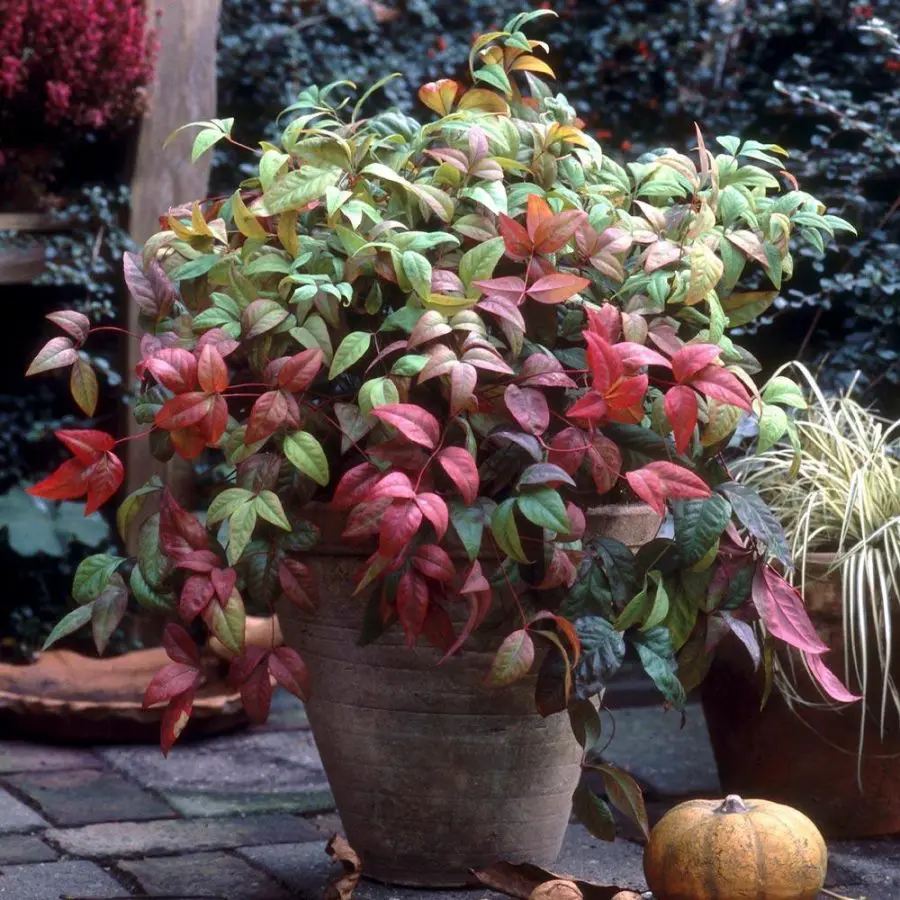
Whether you’re using it to add some color to your plant beds or create a striking border along your driveway, or as a houseplant in a pot the Fire Power Nandina is sure to impress.
And with its low maintenance requirements and long-lasting beauty, it’s an investment that will pay off for years to come.
What makes Obsession™ Nandina Shrubs so special?

The Obsession™ Nandina boasts vibrant colors that are richer, brighter, and longer-lasting than ever before.
This unique variety features a dense, compact growth pattern and brilliant hues that stay vivid for months on end.
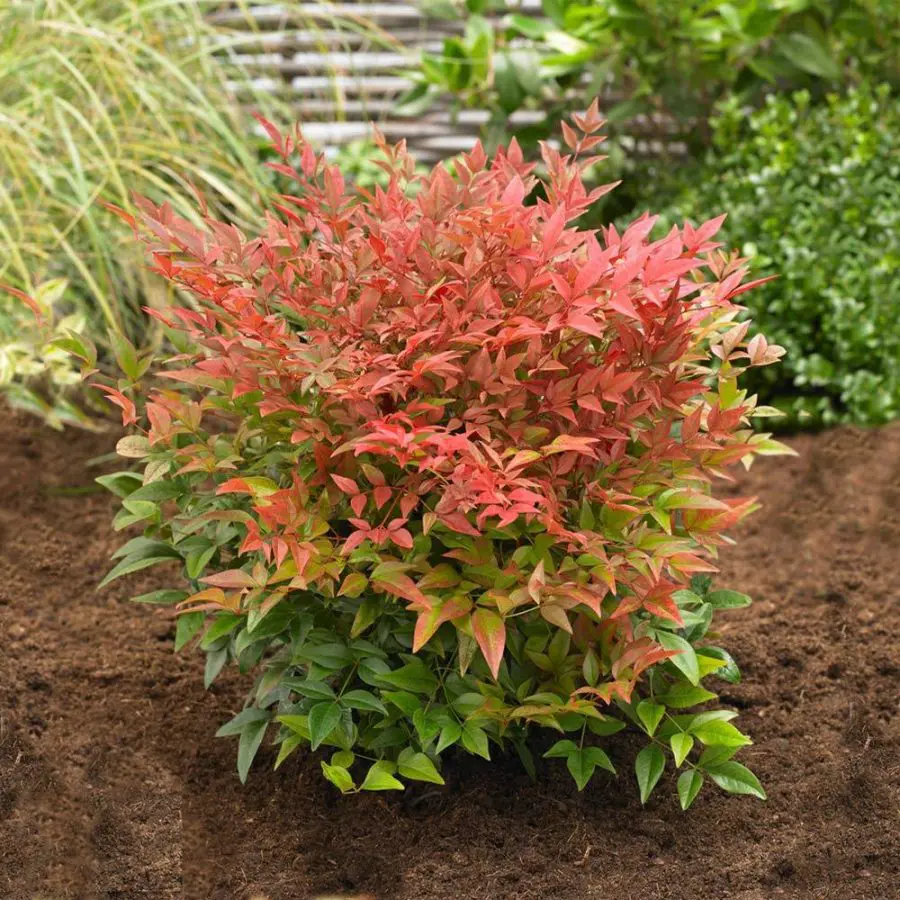
As an evergreen, this plant offers visual interest year-round, and its ability to withstand drought and thrive in tough conditions makes it incredibly versatile.
Whether you’re looking to border your fence, enhance your garden beds, add flair to any landscape, or grow it indoors in pots the Obsession™ Nandina is a top choice.
| Mature Height: | 3-4 ft. |
| Mature Width: | 3-4 ft. |
| Sunlight: | Full-Partial |
| Growth Rate: | Moderate |
| Botanical Name: | Nandina domestica |
| Grows Well In Zones: | 6-10 outdoors |

Growing Zones: 6-10 outdoors (hardy down to 0℉)
Why Choose Nandina Shrubs?
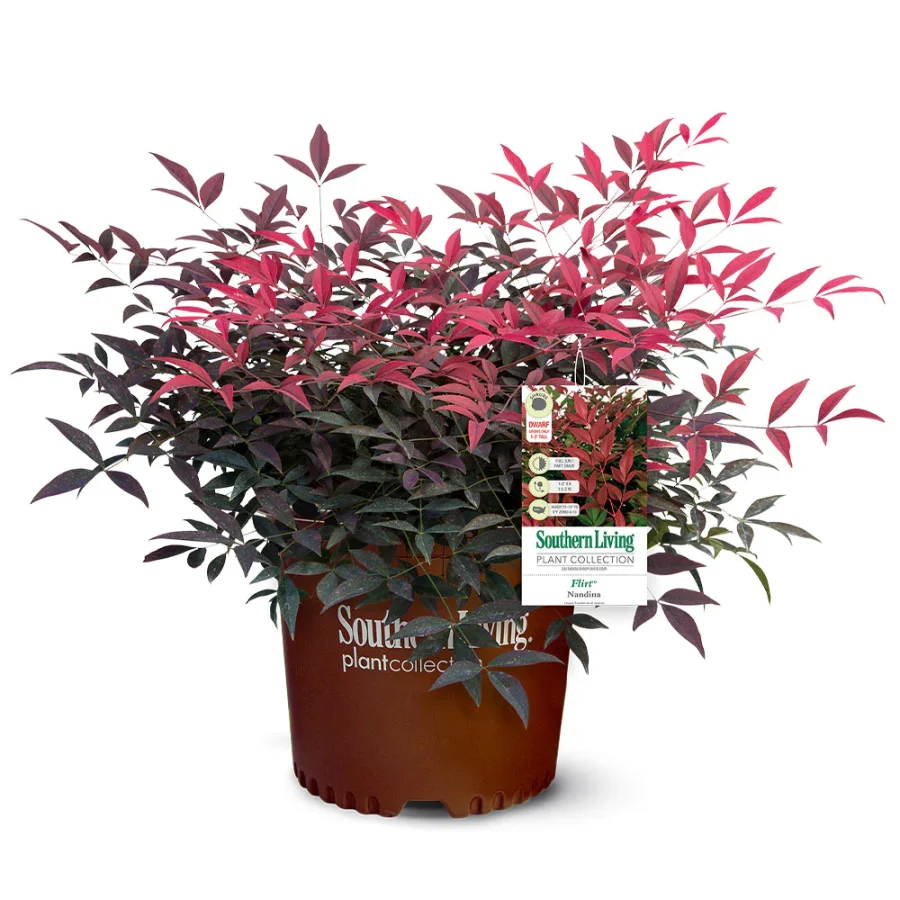
Featuring fiery foliage that spans spring to winter, the Flirt™ Nandina is an exceptional addition to any landscape.
Its rich hues are sure to draw attention, whether you’re using it as a focal point in your plant beds or to border your driveway.
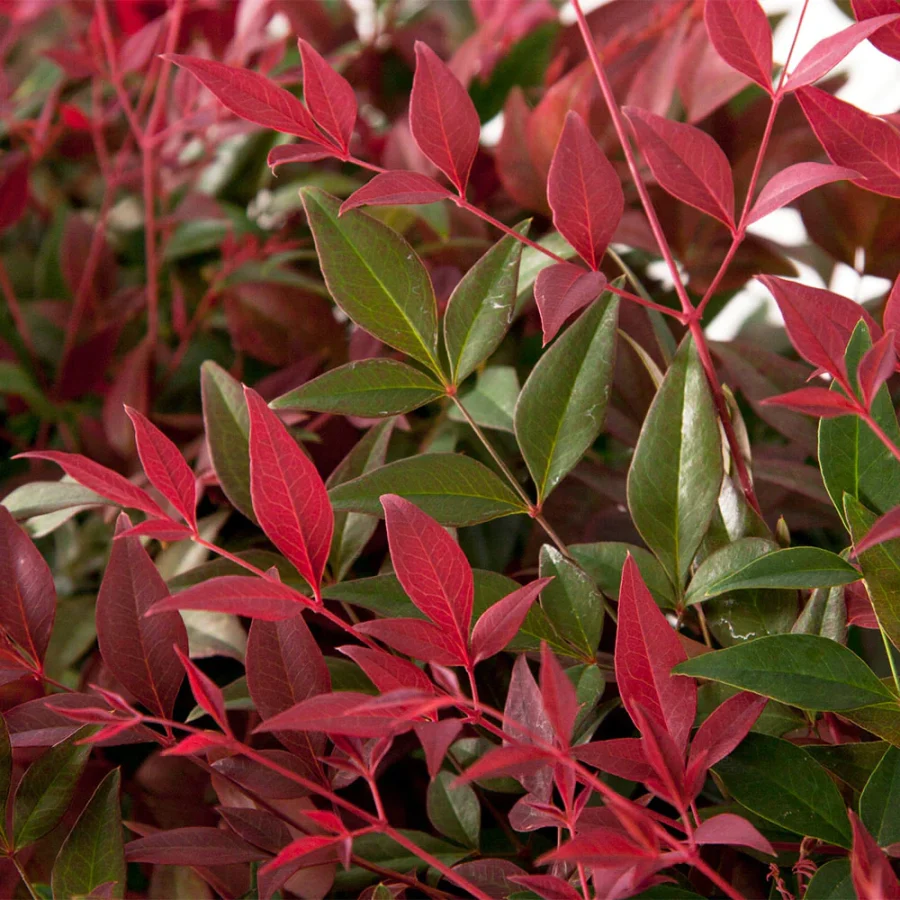
In the summer, its lush blue-green leaves provide a cool and welcoming aesthetic.
But Nandina truly shines with its year-round display of colors, from warm summer tones to the fiery hues of autumn.
Additionally, this plant is incredibly adaptable and drought-tolerant, making it an ideal choice for even the toughest conditions.
| Mature Height: | 1-2 ft. |
| Mature Width: | 1-2 ft. |
| Sunlight: | Full-Part Sun |
| Growth Rate: | Moderate |
| Botanical Name: | Nandina domestica ‘Murasaki’ |
| Grows Well In Zones: | 6-9 outdoors |
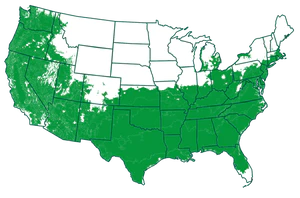
Growing Zones: 6-9 outdoors (hardy down to 0℉)
Growing Heavenly Bamboo in Pots Outdoors
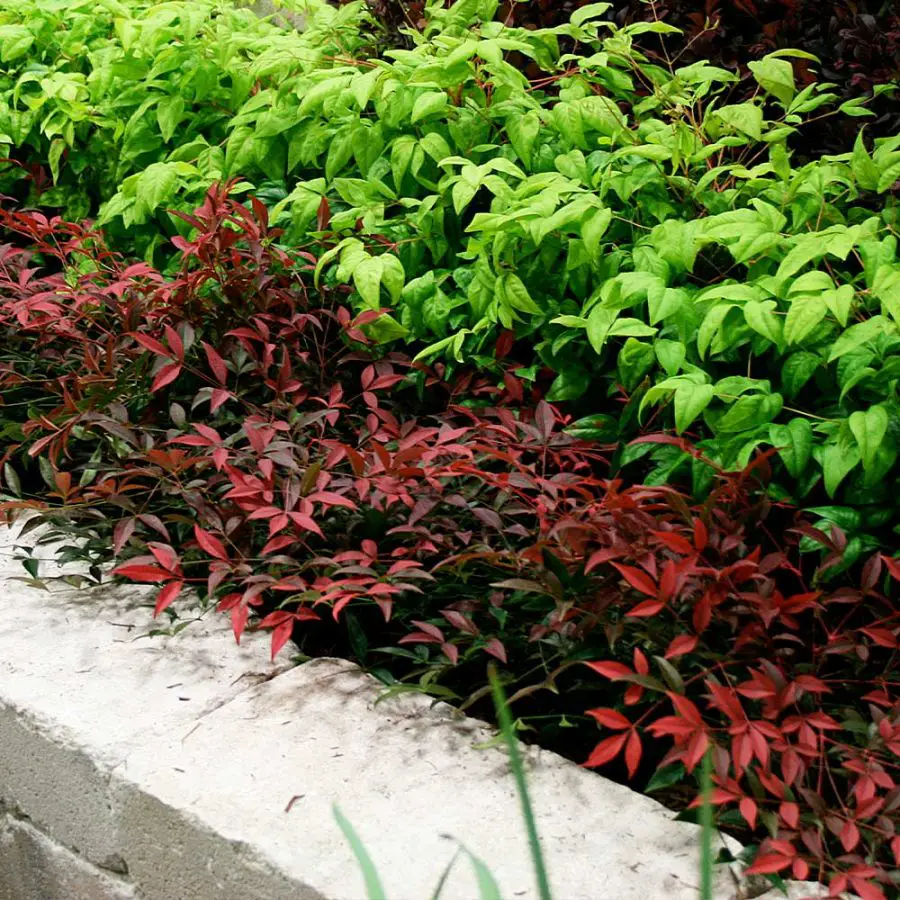
Ready to take your outdoor space to the next level? Look no further than growing Heavenly Bamboo in pots!
These hardy and beautiful shrubs are a great option for sprucing up your patio or garden, and growing it in pots makes it easy to move around and control their growth.
In this section, we’ll cover everything you need to know to grow Heavenly Bamboo in pots outdoors, including pot selection, soil and fertilizer requirements, watering and drainage tips, pruning and maintenance needs, and common pests and diseases to watch out for.
So, let’s get started on creating your perfect outdoor oasis!
How hardy is it?
Heavenly Bamboo is a relatively hardy plant that’s known for being low-maintenance and easy to care for.
It’s a tough shrub with evergreen foliage that’s able to withstand a variety of weather conditions, including heat, drought, and cold temperatures.
In fact, Heavenly Bamboo is able to thrive in USDA hardiness zones 6 through 9, which covers a wide range of climates across the United States.
While it’s always important to provide proper care for your plants, growing Heavenly Bamboo in pots can make it even easier to keep them healthy and happy, as you can control factors like soil moisture and sunlight exposure.
So, whether you’re a seasoned gardener or just starting out, Heavenly Bamboo is a great choice for adding some natural beauty to your space.
What is the lowest temperature it can survive?
Heavenly Bamboo is able to survive in relatively low temperatures and is considered to be a hardy plant.
In general, it’s able to tolerate temperatures as low as 0°F (-18°C) for short periods of time.
However, it’s important to note that while Heavenly Bamboo is relatively cold-tolerant, it’s not a true cold-weather plant and may experience some damage if exposed to extended periods of freezing temperatures or harsh winter weather.
To ensure your Heavenly Bamboo stays healthy and happy, it’s a good idea to provide some protection during particularly cold snaps, such as covering the plant with a frost cloth or moving it to a more protected area.
Pot Selection and Placement Considerations
When it comes to selecting pots for your Heavenly Bamboo, it’s important to choose containers that are the right size and shape for your plant.
Look for pots that are at least 12 to 16 inches in diameter, with good drainage holes in the bottom.
You’ll also want to consider the material of the pot, as some materials like terra cotta can dry out quickly and may require more frequent watering.
When it comes to placement, Heavenly Bamboo prefers full sun but try to find a spot that gets a few hours of partial shade each day.
Soil and Fertilizer Requirements
Like most plants, Heavenly Bamboo thrives in well-draining soil that’s rich in nutrients.
When planting in pots, it’s important to use a high-quality potting mix that’s specifically formulated for container gardening.
You can also add some slow-release fertilizer to the soil to help provide your plants their best start with the nutrients they need to grow and thrive.
Watering and Drainage Tips
One of the biggest challenges of growing a Nandina plant in pots is ensuring proper watering and drainage.
Heavenly Bamboo prefers a soil type that’s consistently moist but not waterlogged, so it’s important to water your plants regularly but be careful not to overdo it.
The first thing is to make sure your pots have good drainage holes in the bottom and avoid letting the pots sit in standing water. You can also add some mulch on top of the soil to help retain moisture.
Pruning and Maintenance Needs
While Heavenly Bamboo is a relatively low-maintenance plant, it’s still important to keep up with regular pruning and maintenance to keep your plants healthy and looking their best.
Prune your Heavenly Bamboo in the late winter or early spring to remove any dead or damaged branches, and to shape the plant as needed.
You can also remove any unwanted suckers or shoots to help control the plant’s growth.
Common Pests and Diseases to Watch For
Like all plants, Heavenly Bamboo is susceptible to a variety of pests and diseases.
Some common issues to watch out for include aphids, spider mites, scale insects, and fungal diseases like powdery mildew.
Keep an eye out for any signs of pest or disease problems, and take action quickly to prevent them from spreading.
You can often treat minor pest or disease issues with organic remedies like neem oil or insecticidal soap.
Growing Heavenly Bamboo in Pots Indoors
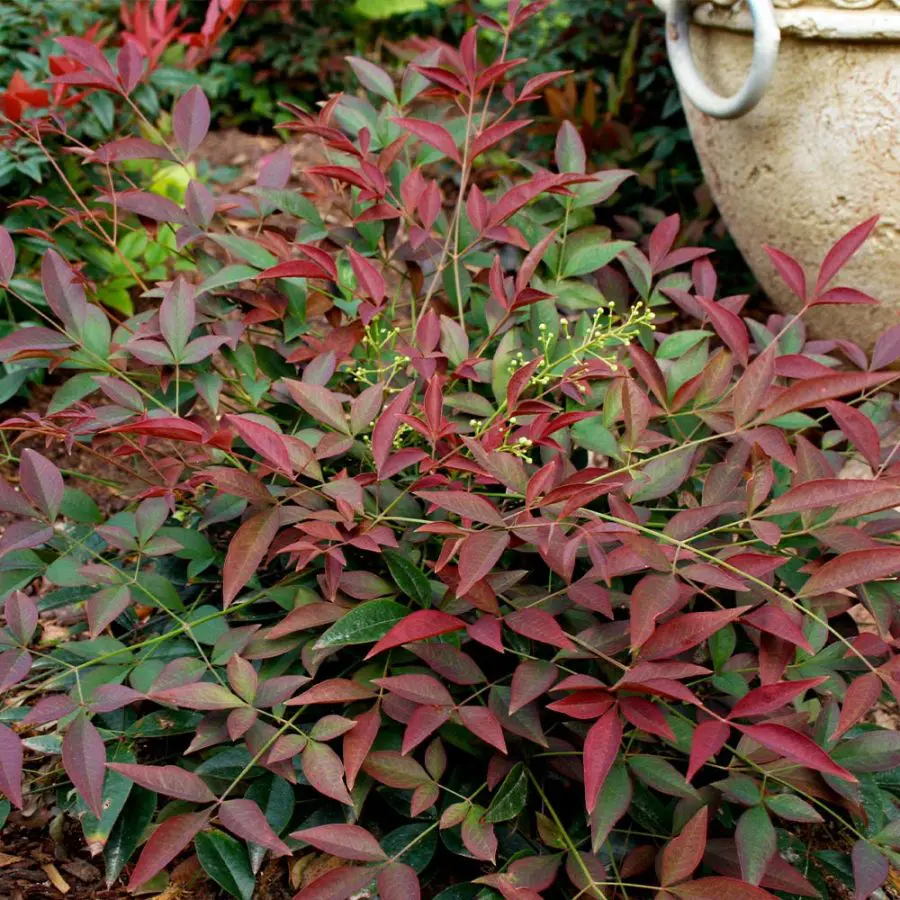
If you’re looking for a way to bring some natural beauty to your indoor spaces, growing Heavenly Bamboo in pots is a great option to consider.
This versatile plant is well-suited to container gardening and can thrive in a variety of indoor environments, from sunny windowsills to more shaded corners.
Plus, not only is Heavenly Bamboo a beautiful addition to any room, it’s also an excellent air purifier, helping to remove toxins and pollutants from the air.
In this section, we’ll explore some tips and tricks for growing Heavenly Bamboo in pots indoors, so you can enjoy the benefits of this lovely plant year-round.
Container and Location Selection
When it comes to growing Heavenly Bamboo in pots indoors, choosing the right container and location is key.
Look for a container that’s at least 8 -12 inches in diameter, with good drainage holes in the bottom.
You’ll also want to consider the location, as Heavenly Bamboo prefers bright light.
A south-facing windowsill is great. But an eastern or western exposure should work.
You can also place your plant under a grow light if necessary.
Soil and Fertilizer Requirements
Like outdoor plants, Heavenly Bamboo in pots indoors also requires well-drained soil that’s rich in nutrients.
I prefer a mix of coco coir and perlite for all my plants. Potting soil can work but I prefer to avoid it because it is peat based.
Harvesting peat destroys our wetlands and releases co2. Coco coir is a much more environmentally friendly choice.
Watering and Humidity Tips
When it comes to watering your Heavenly Bamboo in pots indoors, the key is to keep the soil consistently moist but not waterlogged.
Check the soil frequently and water when the top inch of soil feels dry to the touch.
You can also mist the plant with a spray bottle to help increase humidity, especially during dry winter months.
Pruning and Maintenance Needs
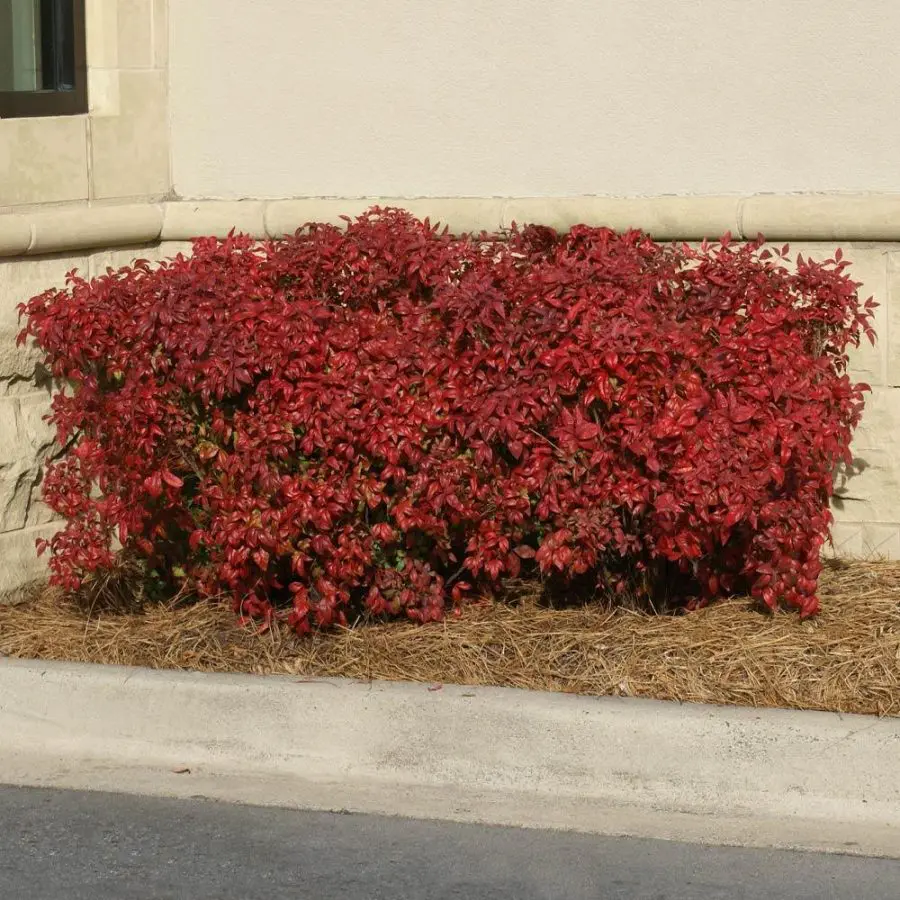
Like its outdoor counterpart, indoor Heavenly Bamboo also requires regular pruning and maintenance to stay healthy and looking its best.
Prune your plant in the late winter or early spring to remove any dead or damaged branches, and to shape the plant as needed.
You can also remove any unwanted suckers or shoots to help control the plant’s growth.
Common Pests and Diseases to Watch For
Indoor plants are also prone to pests and diseases, so keep an eye out for any signs of trouble.
Some common issues to watch out for include spider mites, mealybugs, and scale insects.
To prevent pest problems, make sure to keep your plant clean and free of debris, and avoid overwatering.
If you do notice a pest issue, treat it promptly with an organic remedy like neem oil or insecticidal soap.
Special Considerations for Heavenly Bamboo
While Heavenly Bamboo is a relatively low-maintenance plant, there are a few special considerations you’ll want to keep in mind to ensure your plant stays healthy and happy.
In this section, we’ll take a closer look at some of these considerations, from how to propagate new plants from cuttings to how to deal with any pest or disease problems that may arise.
Whether you’re a seasoned gardener or a newbie to indoor container gardening, these tips and tricks will help you keep your Heavenly Bamboo looking its best for years to come.
Toxicity to Pets and Humans
One thing to keep in mind when growing Heavenly Bamboo is that it can be toxic to both pets and humans if ingested.
The plant produces rich red berries that contain cyanogenic glycoside, which can cause nausea, vomiting, and other symptoms if eaten.
If you have pets or small children in your home, it’s important to keep your plants out of reach and supervise them when they’re around the plant.
Safely Handling and Disposing of Clippings
Another consideration when growing Heavenly Bamboo is how to safely handle and dispose of clippings.
When pruning your plant, it’s important to wear gloves to protect your hands from any potential skin irritation or reactions.
You’ll also want to dispose of any clippings in the trash, rather than composting them, as the plant’s toxicity could potentially harm other plants or wildlife.
Legal Restrictions on Growing Heavenly Bamboo
Finally, it’s worth mentioning that there may be some legal restrictions on growing Heavenly Bamboo in your area.
This is because the plant can be invasive and may crowd out native species if it’s not properly contained.
Before planting Heavenly Bamboo, it’s a good idea to check with your local extension office or gardening center to make sure that it’s legal to grow in your area.
If you’re unsure, you may want to consider growing your plants in pots, which can help contain their growth and prevent them from spreading.
Pruning Heavenly Bamboo in Pots
Pruning is an essential part of caring for Heavenly Bamboo in pots. It helps keep the plant healthy, promotes new growth, and maintains its shape and size.
Whether you’re growing Heavenly Bamboo indoors or outdoors, knowing how and when to prune can make a big difference in the plant’s overall health and appearance.
In this section, we’ll cover why pruning is important, when to prune, how to prune, and share some tips for successful pruning.
Why prune Heavenly Bamboo
• Promotes new growth: Pruning helps stimulate new growth and encourages the plant to produce more leaves and branches.
• Controls size and shape: Heavenly Bamboo can grow quite tall and wide if left unpruned, but pruning helps keep it at a manageable size and shape.
• Removes dead or diseased wood: Pruning also allows you to remove any dead or diseased wood, which can help prevent the spread of pests and diseases.
When to prune Heavenly Bamboo
• Late winter or early spring: The best time to prune Heavenly Bamboo is in late winter or early spring before new growth begins.
This allows you to shape the plant before it starts to grow vigorously.
• Avoid pruning in fall or summer: Avoid pruning in fall or summer, as this can stimulate new growth that may not have enough time to harden off before winter.
How to prune Heavenly Bamboo
• Start with clean, sharp tools: Use clean, sharp pruning shears or loppers to make clean cuts and avoid damaging the plant.
• Remove dead or damaged wood: Begin by removing any dead or damaged wood, cutting it back to healthy wood.
• Thin out the plant: Thin out the plant by removing any weak or spindly branches, as well as any that are crossing or rubbing against each other.
• Shape the plant: Finally, shape the plant by cutting back any overly long branches to a healthy bud or branch.
Tips for successful pruning
• Don’t prune too much at once: Avoid removing more than one-third of the plant’s total growth at any one time, as this can stress the plant.
• Cut back to a healthy bud or branch: When making cuts, always cut back to a healthy bud or branch to encourage new growth.
• Keep tools clean: Clean your pruning tools after each use to prevent the spread of diseases between plants.
Repotting Heavenly Bamboo in Pots
If your Heavenly Bamboo has outgrown its current pot or its roots are starting to show through the drainage holes, it may be time to repot.
Repotting is an important part of plant care and ensures that your plant has enough space to grow and thrive.
In this section, we will cover the ins and outs of repotting Heavenly Bamboo in pots, including when to repot, how to choose the right pot, and tips for successful repotting.
Signs that your Heavenly Bamboo needs repotting:
It’s important to keep an eye out for signs that your Heavenly Bamboo needs repotting, such as roots poking out of the drainage holes or if the plant seems to be drying out quickly despite regular watering. I
f the plant has outgrown its current pot, it may also be time to repot.
Choosing the right pot and soil for repotting:
When choosing a new pot for repotting, it’s important to choose one that is slightly larger than the current pot to allow room for growth.
You’ll also want to choose a well-draining potting mix that is specifically designed for container plants.
Avoid using garden soil, as it may not drain well and could lead to root rot.
Steps for repotting Heavenly Bamboo:
To repot your Heavenly Bamboo, start by gently removing it from its current pot, being careful not to damage the roots.
Loosen the root ball and remove any dead or damaged roots.
Place a layer of potting mix at the bottom of the new pot, then add the plant and fill in around the roots with more potting mix.
Water the plant thoroughly after repotting.
Tips for successful repotting:
To ensure successful repotting, avoid overwatering the plant in the days following repotting to give the roots a chance to settle in.
It’s also a good idea to provide some shade for the plant during the first few days after repotting, as it may be a bit stressed from the process.
Finally, consider fertilizing the plant a few weeks after repotting to help it adjust to its new home.
Propagating Heavenly Bamboo
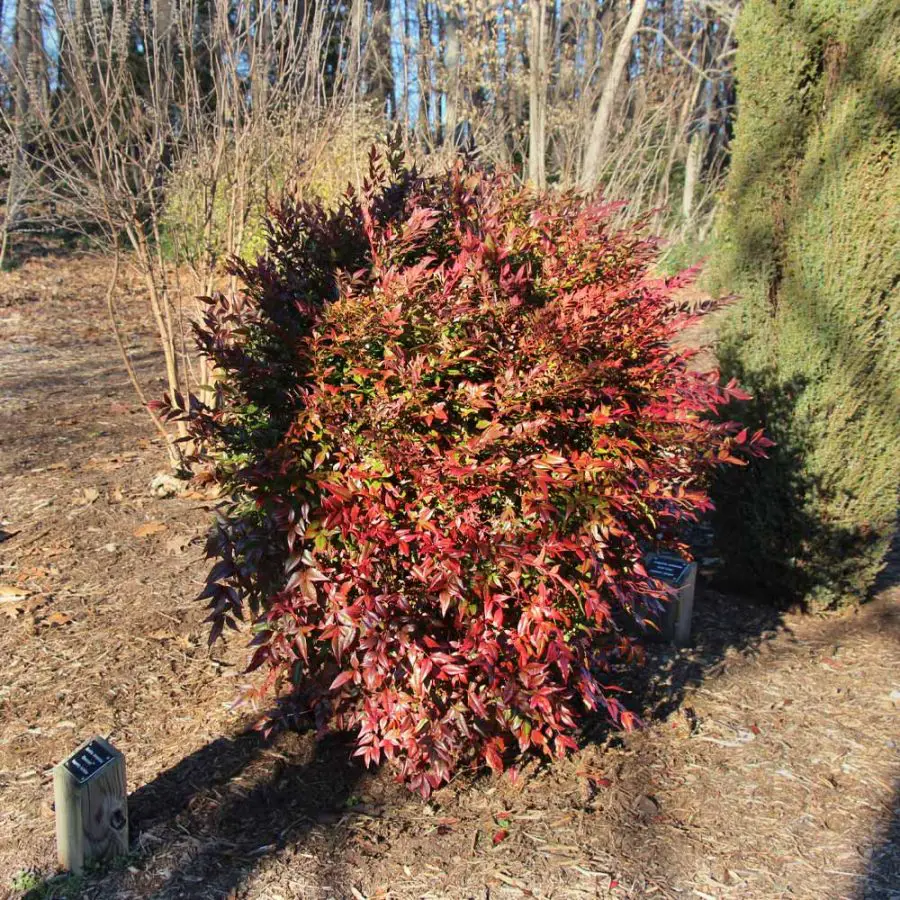
Looking to propagate your Heavenly Bamboo plant? You’ve come to the right place!
Propagating your plant is a great way to create more of these stunning plants and share them with others.
In this section, we’ll cover everything you need to know about propagating Heavenly Bamboo, including the tools and materials you’ll need, the different methods of propagation, and tips for success.
Why propagate Heavenly Bamboo
Propagating your Heavenly Bamboo can be a rewarding and cost-effective way to expand your collection of these beautiful plants.
It also allows you to share your love for this plant with others by gifting them with new starts.
Methods for propagating Heavenly Bamboo
There are two primary methods for propagating Heavenly Bamboo: stem cuttings and division.
Propagating through stem cuttings
Stem cuttings are the most common method of propagation for Heavenly Bamboo.
Select a healthy stem with several nodes, making sure it is at least six inches long. Cut just below a node with a sharp, sterilized knife, and remove the lower leaves, leaving only a few at the top.
Dip the cutting in rooting hormone, then plant it in a pot with moist soil.
Keep the cutting in a warm, bright location and mist it regularly. In a few weeks, you should see roots starting to form.
Propagating through division
Another method of propagating Heavenly Bamboo is by dividing an established plant. A good time to do this is when your plant needs repotting.
This method involves carefully removing the plant from its pot and separating it into smaller sections.
Make sure each section has some healthy roots and leaves.
Repot each section into fresh soil and water thoroughly.
Tips for successful propagation
No matter which method you choose, there are a few tips to ensure successful propagation.
First, use a sterile knife or scissors to prevent disease from entering the plant.
Second, provide a warm and humid environment for the cutting or divided plant to promote healthy root growth.
Lastly, be patient! It can take several weeks or even months for your new plant to grow and establish itself.
Growing Heavenly Bamboo FAQs
Heavenly Bamboo, or Nandina domestica, is a versatile plant often grown in pots and landscapes alike.
Many people have questions about its growth habits, sun requirements, and overall ease of care.
If you’re considering adding this plant to your collection or just curious about its characteristics, the following FAQs should provide the answers you need.
Q: Does heavenly bamboo spread?
A: Heavenly Bamboo is not invasive like true bamboo. It forms a clump and might slowly expand, but it doesn’t aggressively spread through underground runners.
Q: Is heavenly bamboo a good plant?
A: Yes, heavenly bamboo is a popular ornamental plant, known for its year-round interest thanks to its colorful leaves and berries. However, its berries are toxic to pets.
Q: Does heavenly bamboo need full sun?
A: Heavenly bamboo can tolerate a range of light conditions from full sun to partial shade. However, for the most vibrant leaf colors, a spot with plenty of sunlight is preferable.
Q: Is heavenly bamboo easy to grow?
A: Yes, heavenly bamboo is generally easy to care for. It is drought-tolerant once established and adaptable to a range of soil types. It’s a good choice for gardeners of all skill levels.
Growing Heavenly Bamboo In Pots Conclusion
We hope this guide has been helpful in giving you a better understanding of how to grow Heavenly Bamboo in pots, both indoors and outdoors.
From selecting the right pot and soil to pruning and maintenance tips, we’ve covered everything you need to know to keep your plants healthy and thriving.
Remember to keep in mind the special considerations for Heavenly Bamboo, such as its toxicity and potential for invasiveness, but don’t let that deter you from enjoying this beautiful and unique plant.
With a little bit of care and attention, Heavenly Bamboo can make a stunning addition to any garden or indoor space.
Benefits of Growing Heavenly Bamboo in Pots
To recap, growing Heavenly Bamboo in pots offers a number of benefits.
For one, it allows you to grow the plant indoors or outdoors, depending on your preferences and climate.
Potted plants are also easy to move around, so you can experiment with different locations until you find the perfect spot for your plant.
Additionally, growing in pots can help contain the plant’s growth and prevent it from becoming invasive.
Final Tips and Advice for Success
If you’re new to growing Heavenly Bamboo in pots, here are a few final tips to help you get started.
First, make sure to select the right pot and soil for your plant, and pay attention to watering and drainage needs.
Don’t be afraid to prune your plant as needed to keep it looking its best, and keep an eye out for any signs of pests or diseases.
And finally, remember to enjoy the process! Growing plants is a rewarding and fulfilling hobby, so don’t be afraid to experiment and have fun with it.
Read more about Bamboo Plant Indoor Care
Read more about the Benefits Of Keeping Indoor Plants


